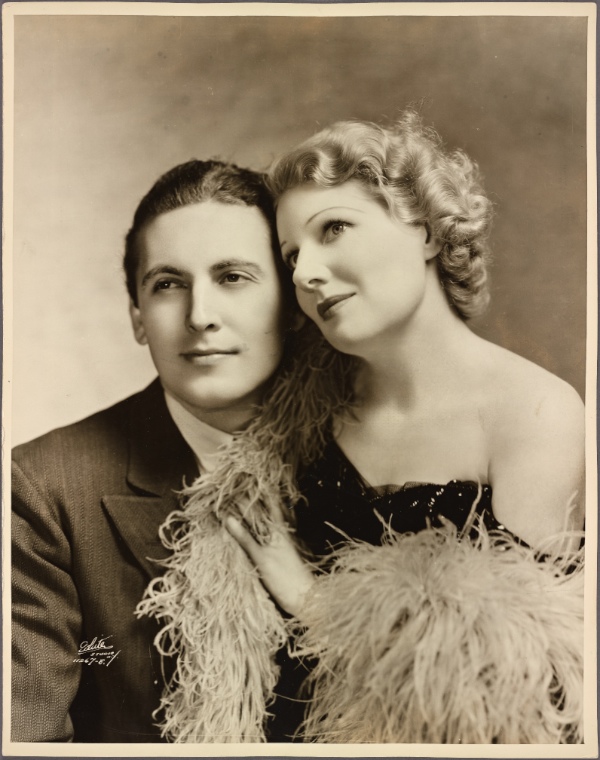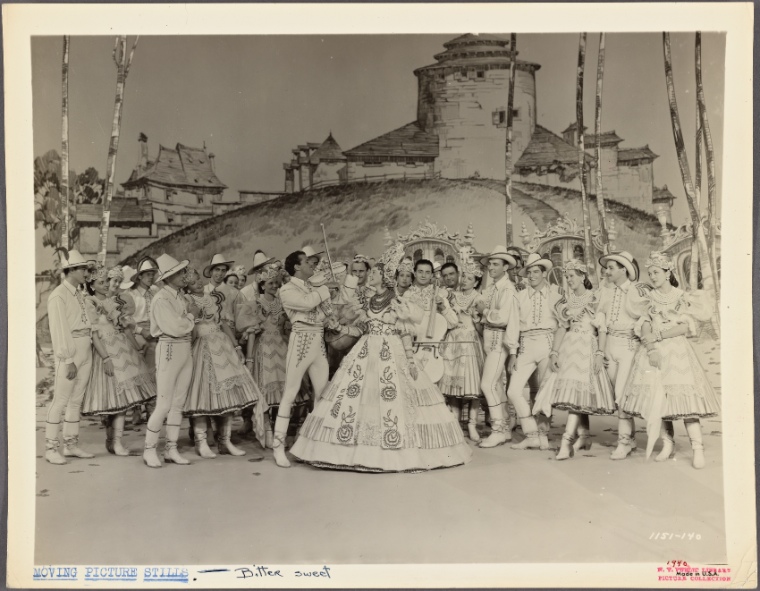Musical of the Month
Musical of the Month: "Bitter Sweet"
A Guest Post by Project Co-Director Professor William Everett

The operette, as Coward called Bitter Sweet, provides a reflexive meta-narrative on musical style, the musical theatrical past, and post-World War I society. Coward's score includes various tropes of Viennese operetta that appear comfortably alongside songs in a cabaret or music hall style and others that reflect contemporary popular dances, most notably the Charleston. The show, though romantic in terms of story and song, ends with its protagonist Sarah Millick/Sari Linden/Lady Shayne courageously facing the future while not ignoring the past. For those who lost loved ones in World War I, the female character was someone to whom they could relate.
Bitter Sweet had its London premiere at Her Majesty's Theatre on July 12, 1929, and opened in New York at the Ziegfeld Theatre just under four months later, on November 5. Notable showmen-producers mounted each production: Charles B. Cochran in London and Florenz Ziegfeld in New York. Coward originally planned to have Gertrude Lawrence play the female lead, but realized that she could not handle his intended vocal demands. The next choice was Evelyn Laye, who refused because her former husband, Sonnie Hale, had a marriage-destroying affair with Jessie Matthews when they were appearing together in Coward's revue, This Year of Grace (1928). And so it was an American actor with strong English diction, Peggy Wood, who played the triple-titled female lead in the original London production. Wood was no stranger to operetta, having created the role of Ottilie in Sigmund Romberg's Maytime (1917), another story of ill-fated love that had at its musical heart a waltz of remembrance in "Will You Remember?" Laye, though she did not create the role in London, headlined the New York production and subsequently led the London cast.
The Plot

The year becomes 1875, and Lady Shayne, transformed into the youthful Sarah Millick, is having a voice lesson with Carl Linden, a musician from Vienna. Even though she is engaged to Hugh, she elopes with Carl and returns with him to his native city.
Act 2 takes place at Herr Schlick's café in Vienna, where Sari, as Sarah is now known, is a singer-dancer and Carl leads the resident orchestra. Manon, a cabaret artist at the café and once-lover of Carl, learns of a devious plan by Schlick to please one of his regular customers, Captain August Lutte. Lutte is interested in Sari and wants to dine privately with her as a prelude to more intimate relations. Schlick forces Sari to dance with his patron, and as Carl watches Lutte make unwelcome advances on his wife, he strikes the Captain. A duel ensues and Carl dies.
When act 3 begins, it is 1895, and Sari has become famous singing Carl's songs. Lord Shayne is hosting a party during which he proposes marriage to the widowed Sari, as he has done several times previously. Sari delights the assembled guests by singing two of Carl's songs, "Zigeuner" and "I'll See You Again." She accepts Lord Shayne's proposal, never forgetting her love for Carl. The time returns to the present day as Dolly, inspired by Lady Shayne's tale, declares her love for Vincent. Vincent in turn enthusiastically expresses his love for Carl's "swell tune," "I'll See You Again."
The Glorious Score
Ivor Novello wrote to Coward concerning Bitter Sweet, saying "The music impressed me unbelievably — it's so gay yet full of thought and has the most extraordinary way of reflecting the story as it goes along" (Barry Day, ed., The Letters of Noël Coward, 156). The score is indeed a remarkable, finely wrought creation. Coward ably draws on music and musical style to enhance his storytelling. Since the romantic leads are both musicians and act 2 takes place at a popular performance venue, it comes as no surprise that music itself plays a central role in the drama.

Although the title suggests a gypsy influence, "Zigeuner" is in fact a lilting waltz. Before she sings it at her engagement party, the future Lady Shayne relates Carl's inspiration for the song. Sailing down the Rhine, he imagined a "lovely flaxen-haired German Princess" falling in love with a Zigeuner. Sari also explains to her audience that "Zigeuner" means "Gipsy." Coward displays a particularly ingenious approach to portray — through music — the cultural differences between the German Princess and her serenading lover. When the exotic lover is not present, the music is resolutely diatonic — no notes outside of the key are present. But whenever the Zigeuner is mentioned, especially when the Princess calls his name, the music becomes much more chromatic and harmonically adventurous. The mysterious Zigeuner resides in a different aural world than the Princess, one that she finds captivatingly attractive.
"I'll See You Again" fulfills the role of principal waltz in Bitter Sweet, cementing the work's ties to Viennese operetta. Its flowing lyricism, moderate tempo, and expansive nature place it closer to the waltzes of Franz Lehár's Die lustige Witwe (The Merry Widow, 1905) or Oscar Straus's Der tapfere Soldat (The Chocolate Soldier, 1908) than to those of Strauss II. It is the first music that Carl and Sarah (as she is called at that point in the story) sing together and provides the aural underpinning for the final scene change, when Sari moves ahead in time to the present, never forgetting her love for Carl.

As quintessential operetta tropes, waltzes are plentiful in Bitter Sweet. When a reflective Lady Shayne sings for the first time, in "The Call of Life," she does so in a moderate-tempo waltz. By contrast, her declaration of love for Carl in the concerted "What is Love?" moves at a notably faster pace; the increased tempo captures her inherent elation. Both of Carl's compositions, "Zigeuner" (which in the 1940 film version is even said to come from an operetta) and "I'll See You Again," are waltzes.
Sarah/Sari/Lady Shayne and Carl are not the only characters to sing waltzes. Manon does as well. Of particular interest is her "Kiss Me," a waltz of regret in which the singer begs for just one more kiss before she and her lover part forever. The song's languid melody and gently chromatic harmonic underpinning add to its underlying pathos.
The waltz is by no means the only musical style found in operetta. In English-language works from the late 19th and early 20th centuries, rousing male choruses emerged as trademarks of the genre. "Brown October Ale" from Reginald DeKoven's Robin Hood (1890), "Drinking Song" from Sigmund Romberg's The Student Prince (1924), and "Song of the Vagabonds" from Rudolf Friml's The Vagabond King (1925) are three famous examples. In Bitter Sweet, the effusive "Tokay" fulfills this role. The rollicking celebratory march, led by baritone Lt. Tranisch, is a paean to life and love.

Loss and nevermore are central themes in Bitter Sweet. Both are central to Manon's "If Love Were All," which ranks among the greatest laments in the entire musical theater repertory. The verse, with its dotted rhythms and abundance of seventh chords, captures the unsettled introspectiveness of its singer through a brilliant union of music and words. The standard AABA refrain, opening with the famous lyric "I believe in doing what I can," offers remarkable emotive insight into the inner strength of a self-effacing character who deeply wants to love and be loved. The singer candidly realizes that this may never happen. Her self-confessed "talent to amuse" at times may be a blessing, but it also can be a curse. The tune's graceful melodic contour — an unassuming descending motif followed by a gradual ascent — captures the lows and highs of the dejected lover's poignant journey. Considered to be autobiographical, the song remains one of Coward's most famous creations and enjoys a deservedly central place in the cabaret canon.
Coward cleverly employs musical style to distinguish between the flashback scenes and those set in the present day. Jazz-inspired rhythms, especially syncopations, fill the show's opening number, "That Wonderful Melody." In the afore-mentioned "The Call of Life," which soon follows, Lady Shayne, whose career took place during the primacy of operetta, sings a waltz, while the young people at the fete respond through evocations of the Charleston and the Blues. Lady Shayne informs her attentive audience that perhaps "the past is interfering" with the present, keenly explaining the juxtaposition of musical styles as the show's temporal setting shifts immediately backwards more than half a century. The soaring syncopation-less ballad refrain of "The Call of Life" is neither a waltz nor a Charleston — it lies between the two and effectively negotiates the journey back in time.
A Charleston likewise concludes the show. "I'll See You Again," following its orchestral reprise that accompanies the action's return to the present day, appears in a Charleston-inspired version as envisioned by Vincent in 1929. Vincent adores the tune in its up-to-date setting, perhaps even more than he loves Dolly. After Lady Shayne sings the final line of the waltz refrain as an act of remembering Carl, the style immediately returns to a Charleston and the show quickly ends. In these final expressions of love, who is the object of affection? For Lady Shayne it is Carl, but for Vincent, it is the music — Coward's music.
Reflexivity
Carl Linden, the male romantic lead, is a composer. But he cannot earn a living solely through writing music. He must also perform. This represents a real-world scenario for many composers early in their careers. Other sources of income were necessary, such as playing piano and leading orchestras in cafés. In the 1940 MGM film adaptation, which starred Jeanette MacDonald and Nelson Eddy, Carl becomes an operetta composer. He creates the imaginary operetta Zigeuner for his wife, Sari. Indeed, the film includes a staged realization of "Zigeuner," complete with Roma musicians and splendid sets.
This was not the only musical dramatic work of its time to feature a composer as a central figure. In the 1930 Warner Bros. film Viennese Nights (music by Sigmund Romberg; book and lyrics by Oscar Hammerstein II), the leading man, Otto, is a composer. As in Bitter Sweet, the story in Viennese Nights takes place over many years and an older version of the female protagonist appears in addition to her younger self. Furthermore, Jerome Kern and Hammerstein's Music in the Air (1932) features a composer at the center of its story, and like Coward does in Bitter Sweet, Kern employs differing musical styles to accentuate plot points and character traits.
Bitter Sweet, written, first performed, and set in 1929, offers strong commentary on the nature of the operetta genre. The young people at the party deem the vaulting operetta music decidedly out of fashion. In the final sequence, Vincent plays a Charleston version of "I'll See You Again," not a waltz one. But the era of operetta, with its glamour, waltzes, and music-filled Viennese cafes, is offered to the younger generation as something to be savored and remembered. The songs of regret, particularly those of Manon ("If Love Were All" and "Kiss Me"), and Carl and Sarah's waltz of future remembrance, "I'll See You Again," become especially poignant when one considers, as did Novello, that these could be written for an entire era and way of life. Pre-World War I society was remembered not necessarily as it truly was, but, now that it was gone, how it might have been.
A note from Doug:
The text of Bitter Sweet is still under copyright in the United States and is posted here for educational and personal use only with the kind permission of the Noël Coward Foundation. Unlike most of the texts published in this blog series (which are public domain), this script may not be performed or redistributed without the permission of the copyright holders. In the United States, schools and amateur groups can rent performance rights for Bitter Sweet from the Tams-Witmark Music Library. Recordings may be borrowed from the Library or purchased from the usual vendors. The Internet Archive also has an abridged version of the show as performed on the 1953 Railroad Hour radio show available for free download. Finally, you can see more photographs from various productions and film versions of Bitter Sweet at the new NYPL Noël Coward online exhibition and, for a limited time, actual artifacts from the original production at the physical exhibition at The New York Public Library for the Performing Arts.
Also note that, in additional to the usual eBook formats, I have included a "video-annotated" version that links the text to relevant YouTube videos. As you scroll past many of the songs, a video will appear in the right-hand column. If you click the text of the music, the video will begin to play. Note that this is an experiment, and so the visual design is rough and the technology has not been thoroughly tested on all Internet browsers. Moreover, neither I nor anyone else from the Library (to the best of my knowledge, anyway) uploaded these videos to YouTube, and so they may be removed or altered at any point. This experiment is meant to give readers a small taste of the music that accompanied the piece and demonstrate the potential for "rich media" annotations of text. In an upcoming blog entry, I will release and document the code that makes this work so you can use it on your own site.
| File type | What it's for |
|---|---|
| Rich Media HTML [BETA] | Web browsers |
| ePub | eBook readers (except Kindle) |
| Mobi | Kindle |
| Adobe Acrobat | |
| HTML | Web browsers |
| Plain Text | Just about anything |
| TEI | Digital Humanities Geeks |
Read E-Books with SimplyE
 With your library card, it's easier than ever to choose from more than 300,000 e-books on SimplyE, The New York Public Library's free e-reader app. Gain access to digital resources for all ages, including e-books, audiobooks, databases, and more.
With your library card, it's easier than ever to choose from more than 300,000 e-books on SimplyE, The New York Public Library's free e-reader app. Gain access to digital resources for all ages, including e-books, audiobooks, databases, and more.
If you don’t have an NYPL library card, New York State residents can apply for a digital card online or through SimplyE (available on the App Store or Google Play).
Need more help? Read our guide to using SimplyE.
Comments
transcription error
Submitted by Anonymous (not verified) on March 27, 2012 - 4:52am
Thanks for pointing that out!
Submitted by Doug (not verified) on March 27, 2012 - 1:09pm
Zigeuner Lyric
Submitted by Jim Bigwood (not verified) on July 30, 2012 - 5:27pm
Excellent artical on Bitter
Submitted by Anonymous (not verified) on May 16, 2012 - 6:13am
1934 Broadway revival
Submitted by Anonymous (not verified) on May 18, 2012 - 3:15am